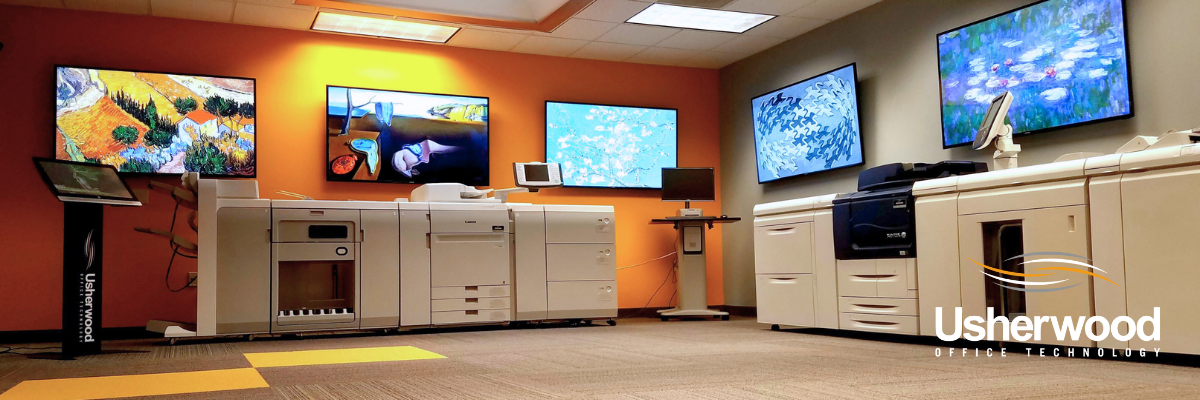By: Jada Sterling, Digital Content Manager on December 21st, 2023
Digital Signage vs Traditional Signage
If you’re considering making the switch from traditional signage to digital signage displays, you should know the key differences. You might be a business leader at a college, doctor’s office, legal firm, restaurant, or other business. No matter what your role, you will need durable, long-lasting, and customizable signage to promote your brand and educate the public. Here is a breakdown of what to expect from digital signage vs traditional signage.
What Are the Various Types of Signage Displays?
Signage can look like kiosks across your campus, posters hanging on walls, free-standing signs in hallways or waiting areas, and digital screens mounted to the wall. Digital signs can also be free-standing, like directories at a mall or a meal ordering stand at a restaurant. Each type plays a different role and can catch eyes in different ways.
Some businesses use interactive digital signage, such as kiosks for checking in or ordering food. Others are meant to inform, like trade show displays promoting your brand, services, or the significance of your industry.
What is a Digital Signage Display?
A digital signage display is a screen that will show information to your target audience. You can display this information via static slides, images, videos, web pages or infographics. You can also display information such as:
- Daily weather reports
- Menu boards
- Waiting queues
- Announcements
- Event information
- Safety Guidelines or Instructions
There are countless uses for digital signs. These screens can be mounted or free-standing, and offer an easy way to display updated signage for various purposes. To read about how digital signage can benefit schools and academic institutions, read our blog: 5 Benefits of Using Digital Signage for Schools.
What Are The Benefits of Sticking to Printed Signs?
Printed signage is a more traditional avenue to display information and branding. This is a power-saving option and carries many benefits. Printed signs will be useful if there is an emergency and the power goes out, which proves especially important if your signs display evacuation procedures.
Installation ease is another draw for printed signage. Posters, infographics or flyers can be taped or pinned to any corkboard or wall, drawing eyes to them in high traffic areas. They do not need to be placed next to power outlets, which makes them more flexible for placement locations.
Cost Differences
Printed signs are relatively inexpensive compared to purchasing digital monitors. This may backfire, however, as printed signs can easily become outdated and need to be replaced. Digital signs have an edge over traditional in this sense, as they can be quickly updated with correct information. If you want a more cost-effective solution for the long run, digital signs are the way to go.
Eco-Friendliness of Print vs Digital Signage
A common concern for businesses is the desire for sustainability. As previously mentioned, printed signs may become obsolete once information or seasonal campaigns change. This would render printed materials much less sustainable than digital signs.
To read more about print sustainability and how to retain your printing capabilities while being kind to the planet, read our article: Is Printing Bad for The Environment? Eco-Friendly Printing Solutions Can Reduce Your Carbon Footprint.
Tampering and Durability Considerations
As you might assume, printed materials are prone to vandalism. What was once a creative and informative representation of your business could be subject to tears, doodles, water damage, and more. There are unintentional hazards for printed signs as well. Free-standing signs can be tipped over, and posters or banners could fall and get stepped on.
In terms of durability, digital signage will be more stable as it is often mounted to the wall. Free standing kiosks will typically be more stable and less prone to falling or getting damaged. Like anything, though, tampering, impact, and environmental factors could lead to damage, which would be more costly than a damaged printed sign.
What is the Difference Between a Digital Signage Display and TV?
A common misconception is that digital signs are the same as TVs. Electronic displays can get much brighter than TVs, although this may lead to more energy consumption. TVs are often not equipped for the operation demands that displays are designed for, so they can stay turned on for longer. Digital signs also have more robust connectivity options, so you can do more with them than a TV.
Why Use Digital Signage in Marketing?
Marketing to a large audience is a visual effort. Creating stunning digital content is a great move. Yet, if you can’t properly display them or provide multiple interesting things to look at, your audience might lose interest. Gone are the days when one static image alone can hold an onlooker’s attention.
Moving graphics, promotional videos, and other dynamic media are fantastic tools for promoting your brand or services. For this reason, traditional signage just doesn’t hold up to the capabilities of digital signage.
Industries That Can Most Benefit from Digital Signage
Digital signs can be used for any number of purposes and in any setting. The types of businesses that can benefit from a digital signage solution include but aren't limited to:
- Restaurants
- Doctor’s offices
- Manufacturing facilities
- Retail stores
Many schools and colleges already use digital signage to promote countless events and campus announcements throughout the school year. To read more about applications of electronic signage solutions in academic settings, read our blog: 5 Benefits of Using Digital Signage for Schools.
How to Switch to Digital Signage Displays
If you’re ready to explore your options for elevating your marketing and signage efforts, find a quality managed communications provider to partner with. They can help you decide on the right solutions for your goals, so you get the most out of your budget while enjoying the benefits of this technology. Click the link below to speak to a managed communications expert about the possibilities.
Read On

5 Benefits of Using Digital Signage for Schools
If you’re a school administrator or teacher, you know it’s getting tougher and tougher to keep...

Client Journey: Warwick, RI Mall Revamps Digital Signage to Revitalize Shopper Experience
Warwick Mall, located in Warwick, RI, needed a solution to an outdated fleet of signage kiosks...

Surprising Industries That Are Moving to Digital Signage
Digital signage is a useful tool for any industry, allowing business owners to display menus,...




